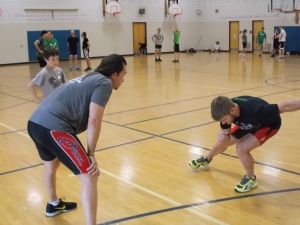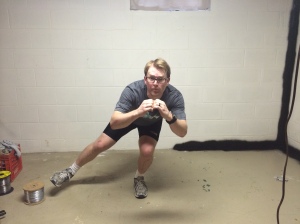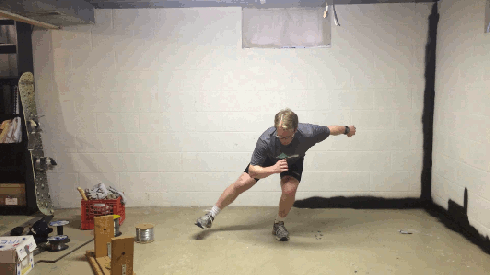There have already been two very good reports on this Clinic here and here, and I don’t want to regurgitate a review of the entirety of the event. However, I do think it is worth posting what I learned, in addition to a little about the event, and some pictures/video.
This was a unique clinic, as I understand the clinics that Joey typically run are optimized for indoor racing around a 100m flat track that typically take place in roller rinks on coated wooden floors. Pretty much the entire group in attendance at this clinic skated outdoor over marathon distance. His original intent was to run the clinic at the Roseville Oval in Roseville, Minnesota. However, the weather didn’t cooperate, and we ended up using the back-up location at a nearby elementary school. While the venue ended up being indoor, the clinic focused entirely on technique, including the double push.

Joey Mantia working with skaters in Roseville, MN. Image courtesy of www.inlineskatempls.com
We did two sessions, and at the start of each session we started off with dry land training. Joey showed us the basics of body position and focused heavily on weight transfer. He said that the core of efficient skating is weight transfer, and many of the drills dealt with balance and weight transfer. We spent a lot of time off-skates in the skater squat, which looks something like this:
I say something like this because I am not as low as I could be. If you look very closely at the picture from the front, you can see that my knees are collapsing in a little bit, notably on the right side. I shot these pictures after a heavy lift/plyo work out, so I was a bit rickety. Everything in skating basically starts from here. The only significant variation in body position is how deep you sit in the skater squat. As for the actual weight transfer, there were a couple of terms that kept coming up that are good points to focus on.
First, “leading with the hip” is something often said by coaches, but something I didn’t really understand until asking for clarification during the Clinic. The idea of leading with the hip is really a way of communicating where your body position should be when balancing on one leg in the skater squat. The hip should be positioned to the outside of the foot on which you are standing. The idea here is all about where your center of gravity is to distribute your weight so you can remain balanced and used weight transfer to generate push power. It should look something like this:
The picture on the bottom shows the concept of leading with the hip better than the picture on the top. You can see my hip position is beyond the outside of my foot. This also helps to line up my nose, knees, and toes. That is the second term that is often used in describing technique, and something that came up over and over again during the clinic. The concept of “nose-knees-toes” describes the position your body should be in during the glide phase of the push when skating. The idea here, when looking at your body position from the front, is to see your nose, knees, and toes aligned vertically. Neither of these pictures show this position adequately. The picture on the top shows good knee-toe position with my head a little far to the right. The picture on the bottom shows good alignment of my nose, knees, and toes, but my balance is off. Ideally, your nose-knees-toes should align perpendicular to the ground, or as Joey says, “imagine a line from your foot to the ceiling lining up your nose, knees, and toes.” This is a great way to think about where your body position should be, even if these aren’t the best examples. Weight transfer is the next part of the drill, and this basically requires you to shift your weight between these two positions stalling on one foot. As a check for balance, it helps to lift the opposite foot, or recovery foot, off of the ground. If you are well balanced, you should be able to lift the opposite foot off of the ground, but do so without a jerk or jump. It may look something like this:
This image was created from some video of my dry-land skating. You can see the the nose-knees-toes alignment here, but another important technique issue comes to light when reviewing the video. The hips and shoulders should remain steady and on the same line. I discussed this in my post about slide-board earlier this year. This is accomplished by engaging the core and focusing on lateral movement through the hips. You can also see here how leading with the hip works, as my hip on each side moves past the center-line over the foot. It isn’t perfect, though, as there is still some weakness in my right knee and a slight hop on raising my foot off the ground that causes my hip to shift up slightly on each side.
Weight transfer is what allows you to put power in the push without expending extra energy. It is pretty much the Holy Grail of skating. So much so that you could skate only with weight transfer on classic push and add the double push to average 18 miles per hour. Well, at least he can. These drills provided me with very concrete examples of where my technique is failing. You can see this stuff in books and on the internet, but it never really sinks in until someone coaches you and/or you see it demonstrated first hand. The key to fast skating over marathon distances is efficiency. Something I have known and been working on, but these drills are the tools that will hopefully make me more efficient, and, as a result, faster.
After all of the off-skate work, we got on skates and basically did the same set of drills standing and then rolling. We also did a lot of drills to make us aware of our edges. The idea here was to get better on our skates, work balance, and be more in control of the skates rather than having the skates be in control of us. Joey mentioned that Justin Stelly doesn’t have to train very hard to be fast because he is so good at controlling his skates. He makes a good point, and being able to control my skates is something that I need to work on. I am planning on adding a lot of these on-skate drills to my training. Looks like I will be in the market for some cones. I was only able to capture video of the first half of the day, but you can see the drills in the following video:
I had the opportunity to have lunch with Joey and a couple of the guys that organized the clinic. He had some really interesting insights on the sport, on the coaching situation for US Speed Skating on the ice side, and his plan to race indoor and outdoor nationals this year. I am glad to see he is staying so active in the inline community, as it seems that some of the Olympians that have made the switch to ice haven’t done much for inline since finishing the Olympics. Of particular note, Joey says he doesn’t think inline should be trying to be in the Olympics because of the limited number of medals. I think he is right, too. His analogy was that if it were a winter sport, it would already be in the program, but since the summer program is so packed, you would be taking medals away from other sports, and “if wrestling isn’t safe, no one is.”
The afternoon started with more dry land and then back to skates. The dry land session was a rehash of what we did in the morning and was very helpful in solidifying the drills to memory. The afternoon on-skate session dealt with double push. He showed us a lot of drills originally designed by Eddy Matzger. It was a great session, and I realized, in the room full of local skating luminaries, that we all have things we need to work on. Following Joey’s philosophy, you have to work hard at the things you are bad at doing in order to get better. There are a couple of videos floating around YouTube of the event and there are several posted in InlineSkateMPLS that are worth checking out.
After the afternoon on-skates session, Joey did some question and answer and then demonstrated some drills and technique on the slide board. The most shocking thing I learned during the Q&A was that Joey doesn’t lift weights. He has legs like tree trunks, but doesn’t lift. I was, and still am, shocked. The secret to his strength is isometric and plyometric exercise. He does wall-sits to failure, which, for him, is 5 to 10 minutes. He also demonstrated some very basic plyos, many of which I am doing, but some that I am working into my workouts. The biggest new change, though, will be wall sits to failure. I am not going to replace lifting weights with plyos and isometric work outs because I am too far behind to work up to that level of strength, and I don’t see any negative effects from weight lifting on my skating. This also was another interesting lesson, just because it doesn’t work for Joey doesn’t mean it won’t work for me.
Overall, this was a great experience. I would highly recomend that anyone who has an interest in becoming a better skater attend this kind of clinic, taught by Joey or any other world class skater.




